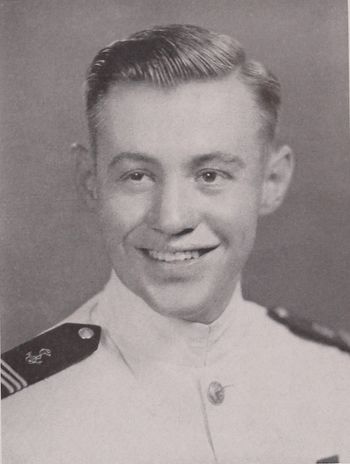WILLIAM W. WILLIAMS, ENS, USN
William Williams '43
Lucky Bag
From the 1943 Lucky Bag:
WILLIAM WADSWORTH WILLIAMS
Potter Valley, California
His red hair, freckled face, dimpled cheeks, and ready smile indicated that Bill was an athlete, a ladies' man, and a "savoir" all rolled into one. His numeral covered bathrobe readily signified his ability in both plebe and varsity lacrosse and soccer. Bill's locker door, covered with pictures, boasted of his feminine attraction—snaking and jitterbugging were his specialties. And, as his grades revealed, Bill was a savoir, a real star man. He was fond of reading or talking, in fact, he was always ready to tell anyone about deer hunting, sheep raising, Northern California, or W. W. Williams.
He was a member of the soccer team and of the lacrosse team.
The Class of 1943 was graduated in June 1942 due to World War II. The entirety of 2nd class (junior) year was removed from the curriculum.

WILLIAM WADSWORTH WILLIAMS
Potter Valley, California
His red hair, freckled face, dimpled cheeks, and ready smile indicated that Bill was an athlete, a ladies' man, and a "savoir" all rolled into one. His numeral covered bathrobe readily signified his ability in both plebe and varsity lacrosse and soccer. Bill's locker door, covered with pictures, boasted of his feminine attraction—snaking and jitterbugging were his specialties. And, as his grades revealed, Bill was a savoir, a real star man. He was fond of reading or talking, in fact, he was always ready to tell anyone about deer hunting, sheep raising, Northern California, or W. W. Williams.
He was a member of the soccer team and of the lacrosse team.
The Class of 1943 was graduated in June 1942 due to World War II. The entirety of 2nd class (junior) year was removed from the curriculum.
Loss
William was killed by small arms gunfire while serving as the junior officer of the deck aboard USS Growler (SS 215) on February 7, 1943. The boat was engaged with a Japanese convoy escort vessel at the time.
Other Information
From the Class of 1943 anniversary book "25 years later…":
Bill was born on 8 January 1920 in Patter Valley, California. He was appointed from at-large and entered the Academy on 21 June 1939. Upon graduation he reported to the Submarine Base, New London, Connecticut for submarine instruction. Upon its completion he reported to the Commander, Submarines Pacific Fleet and to the submarine USS GROWLER which was soon on its fourth war patrol between Rabaul and the Western Solomons.
On 7 February 1943, slightly after midnight the GROWLER traveling on the surface passed an enemy ship on opposite course with it. Each turned to attack but poor weather hid the Japanese 2,500 ton gunboat’s maneuver until the range was t0o short to fire a torpedo, so the captain chose to ram the gunboat. The Captain, Bill and three lookouts were on the bridge as it was raked by the machine gun fire which killed Bill and one lookout and wounded the captain. The gunboat sunk. The submarine was saved by the captain remaining topside as the submarine dove to safety.
Bill was entitled to wear the Purple Heart, American Defense Service Medal with Fleet Clasp, Asiatic-Pacific Area Campaign Medal with one bronze star. He was survived by his mother, Mrs. Grace Lovell Williams who at Bill's death resided at Box 105, Patter Valley, California.
From The Press Democrat on February 14, 1943:
… Ensign Williams was graduated from Ukiah High School, and was appointed from the R.O.T.C. at University of California to Annapolis for training with the navy. During graduation week last year his engagement to Miss Phyllis Kadel, daughter of Dr. and Mrs J. Edwin Kadel of Port Jervis New York, was announced.
William is listed at the Manila American Cemetery and Memorial.
Full Biography
From Stories Behind The Stars, via fold3:
Ensign William Wadsworth Williams (SN O-165814) was born on January 8, 1920, in Potter Valley, Mendocino County, California. His parents were Leo Burr Williams and Grace Lovell Bradford, who were farmers. In 1930, Bill was living with his family on a farm in Ukiah, California. He graduated from Ukiah High School.
William initially attended the University of California, Berkeley, and was in the Navy ROTC. In his sophomore year, William participated in a nationwide examination for selection to the US Naval Academy. William received the highest grade in the nation. William received an appointment to the U.S. Naval Academy after completing his physical exam and on 21 June 1939 became part of the USNA class of 1943. His class was accelerated because of the war, and the entirety of his 2nd class (junior) year was removed from the curriculum. Bill was a member of the soccer team and the lacrosse team. He graduated with distinction a full year early in June 1942. During his graduation week, his engagement to Miss Phyllis Kadel, of Port Jervis, New York, was announced.
Upon graduation, Ensign Williams volunteered for the submarine service and reported to the Submarine Base, New London, Connecticut for submarine training. Upon completion of the training, he reported to the Commander, Submarines Forces, Southwest Pacific and was assigned to the crew of the USS Growler (SS-215). The USS Growler was a Gato-class fleet submarine built in Groton CT by the Electric Boat Company. It was commissioned on 20 March 1942.
The USS Growler began its fourth war patrol on 1 January 1943 from Brisbane, Australia and headed for the Truk-Rabaul shipping lanes. The Growler arrived in its patrol area on 11 January. The patrol area was soon alerted as the Growler made several attacks in the following weeks. On 7 February 1943, slightly after midnight, the Growler was traveling on the surface charging batteries and the captain, CDR Howard Gilmore, saw an enemy ship on the opposite course. The ship was an armed food supply vessel, the Hayasaki. [Some early accounts use the term “gunboat” but later versions after the war state that the enemy vessel was a provision ship.] Each vessel turned to attack, but Growler’s crew was slow to detect the target’s change in course because poor visibility hid the Japanese ship’s maneuver until the range was too short to fire a torpedo. The ship suddenly loomed out of the darkness. The captain turned to evade the collision and rammed the enemy ship at 17 knots. The Growler hit the Hayasaki amidships and the “impact was terrific.” The Growler’s bow was bent 18 feet to the port side. The crew of the damaged Hayasaki manned its machine guns, directing a withering fire at Growler’s bridge. The captain, Bill Williams, who was the assistant officer of the deck, and three lookouts were on the bridge as it was raked by the machine gun fire which killed Bill and one lookout (Fireman 3rd Class Wilbert Fletcher Kelly). The captain was wounded. He shouted, “Clear the Bridge!” and the Officer of the Deck, the Quartermaster, and two wounded lookouts hurried down the hatch to the conning tower. The Executive Officer, Lieutenant Commander Arnold F. Schade, stood at the foot of the ladder waiting for Gilmore. Then came another shout from Gilmore to “Take her Down!” LCDR Schade shut the hatch and dived the boat. The submarine and its crew were saved when the captain remained topside and ordered the crew to dive to safety.
The USS Growler survived the significant damage received in this action and returned to Brisbane on 17 February 1943 for repairs. Growler completed six more war patrols between May 1943 and September 1944. While on her 11th war patrol, the USS Growler, with 86 of its crew members, was lost in November 1944.
ENS William W. Williams received the Purple Heart, American Defense Service Medal with Fleet Clasp, Asiatic-Pacific Area Campaign Medal with one bronze star. His brother, Bradford R. Williams served in the US Army Signal Corps from 1942 to 1946.
The bodies of ENS Williams, CDR Gilmore, and F3C Kelley were not recovered and were presumed to be washed off the boat when it submerged. CDR Gilmore was awarded the Medal of Honor for saving his crew.
Related Articles
Howard Gilmore '26 was also lost in this action; CDR Gilmore was awarded the Medal of Honor.
The USS Growler survived the engagement and completed six more war patrols before being lost with all hands in November 1944.

The "category" links below lead to lists of related Honorees; use them to explore further the service and sacrifice of alumni in Memorial Hall.